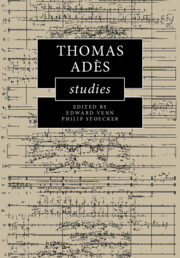Book contents
- Thomas Adès Studies
- Thomas Adès Studies
- Copyright page
- Dedication
- Contents
- Figures
- Tables
- Music Examples
- Online Materials
- Contributors
- Preface
- Acknowledgements
- Notes on the Text
- 1 ‘Chronically volatile’
- 2 Performing Adès
- 3 ‘Fountain of Youth’, ‘River of Meaning’
- 4 ‘Oh brave new Caliban’
- 5 Chaconnes in the Music of Adès
- 6 Closing the Circle?
- 7 A World in Constant Motion
- 8 Musique automatique? Adèsian Automata and the Logic of Disjuncture
- 9 Narrating the Dance of Death
- 10 Hearing Voices in Adès’s Operas
- 11 The RICH Logic of Adès’s The Exterminating Angel and The Tempest
- 12 Sonic Allegory in Adès’s The Exterminating Angel
- Bibliography
- Index
10 - Hearing Voices in Adès’s Operas
Published online by Cambridge University Press: 18 November 2021
- Thomas Adès Studies
- Thomas Adès Studies
- Copyright page
- Dedication
- Contents
- Figures
- Tables
- Music Examples
- Online Materials
- Contributors
- Preface
- Acknowledgements
- Notes on the Text
- 1 ‘Chronically volatile’
- 2 Performing Adès
- 3 ‘Fountain of Youth’, ‘River of Meaning’
- 4 ‘Oh brave new Caliban’
- 5 Chaconnes in the Music of Adès
- 6 Closing the Circle?
- 7 A World in Constant Motion
- 8 Musique automatique? Adèsian Automata and the Logic of Disjuncture
- 9 Narrating the Dance of Death
- 10 Hearing Voices in Adès’s Operas
- 11 The RICH Logic of Adès’s The Exterminating Angel and The Tempest
- 12 Sonic Allegory in Adès’s The Exterminating Angel
- Bibliography
- Index
Summary
The innovative ways in which the human voice is used in performing Thomas Adès’s operas Powder Her Face, The Tempest and The Exterminating Angel, have ensured sustained critical attention on voice and vocality in these works. There has, however, been little academic scholarship on the role of the voice in Adès’s operas to date. Reconciling hermeneutic approaches to voice, phenomenal song and narrative with a more recent material turn in voice studies, this chapter will discuss a range of interpretatively salient moments in Adès’s operas, in which the sound and activity of the resonant singing voice itself is used as a narrative parameter independently of what these operatic voices have to say. It aims to interrogate the play between voice as embodied sonority and more metaphorical conceptions of voice as vehicle for meaning, as a way to access and understand traits in the relationship between surface and structure, and the use of musical techniques for semantic ends. In doing so, this chapter provides a long-overdue theoretically grounded hearing of the sonorous voices in Adès’s music and of the performers that capture our attention from the operatic stage.
Keywords
- Type
- Chapter
- Information
- Thomas Adès Studies , pp. 213 - 232Publisher: Cambridge University PressPrint publication year: 2021

